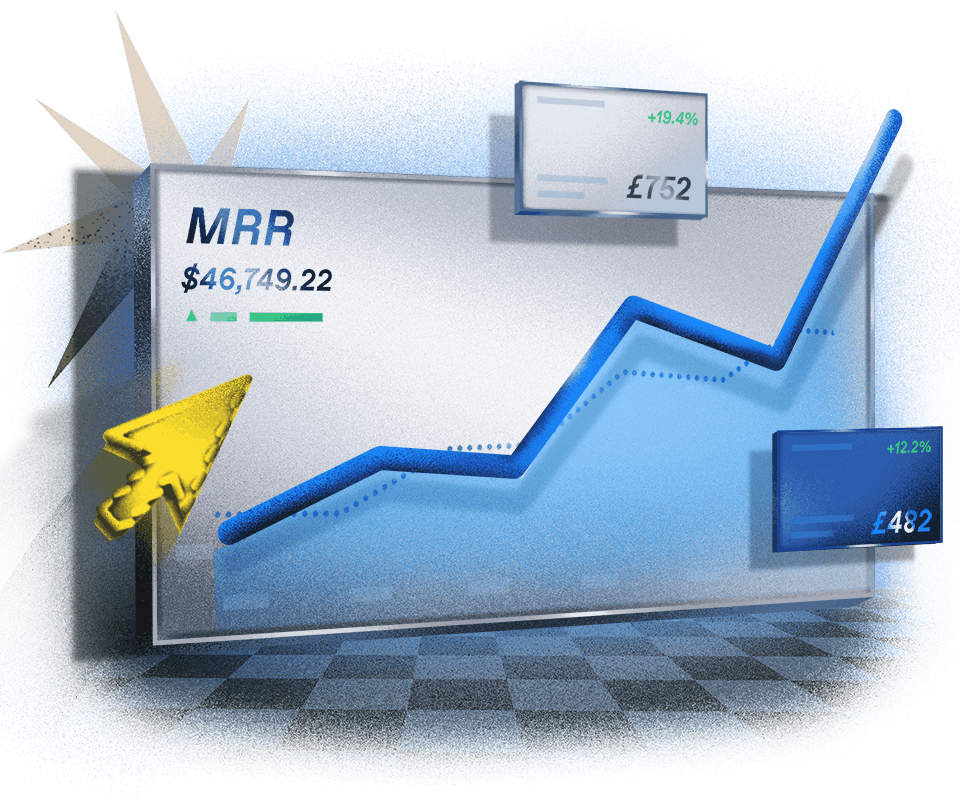An A-Z of SaaS metrics
Do you know your ARPU from your EBIT? There's a SaaS metric for everything these days. Find the right ones for you below.

A
AARRR (pirate metrics)
AARRR is a framework encompassing five user-behaviour metrics: acquisition, activation, retention, referral, and revenue.
Learn more about AARRRAnnual contract value (ACV)
The average annual revenue a business will generate from each customer contract. It's a metric usually used by businesses that sell annual or multi-year contracts.
Learn more about ACVAnnual recurring revenue (ARR)
The amount of money a business gets from its subscription customers that is recognized on an annual basis. ARR is an indicator of growth or contraction and a predictor of future revenue.
Learn more about ARRAttrition (employee)
A measure of how many employees leave a business over a given period of time. Expressed as a percentage, a business' attrition rate is the number of employees that leave in a given period, divided by the average number of employees, multiplied by 100.
Learn more about employee attritionAverage revenue per user (ARPU)
A measure of the revenue generated by each user over a given period of time, taken as an average. ARPU can be used by any business, but it's more relevant for those with a recurring revenue model, such as subscription companies.
Learn more about ARPUAccrued revenue
Earnings from providing a product or service, where payment has yet to be issued to the provider and is recorded as a receivable owed by the customer for the business transaction.
Learn more about accrued revenueAttrition (customer)
The loss of customers is known as customer attrition – it's an important indicator of the health of your business, whichever industry you're in. In SaaS, attrition is commonly referred to as customer churn.
Learn more about customer attritionB
Burn rate
Your total revenue minus your total expenses in a given period. Usually measured monthly, burn rate tells you how much money your business loses (or "burns") in that time.
Learn more about burn rateC
Churn
The number of customers that stop doing business with you over a period of time. Or the amount of revenue lost from those customers (known as revenue or MRR churn)
Learn more about churnClosed won/lost
When a prospect makes payment or signs the contract, a deal can be marked as ‘closed-won'. But if they choose an alternative solution, the deal is considered ‘closed-lost'. A sales rep’s ratio of closed-won to closed-lost shows how efficient they are overall.
Learn more about using win/loss dataCost of goods sold (COGS)
The amount it costs to produce and deliver the product or service you sell. Understanding COGS in your business will help you to calculate your gross margin - that is how much you’ll have left for other services/aspects of running your business
Learn more about COGSCost-per-hire (CPH)
How much it costs your company to hire an employee. You can also use this metric to track the return on investment for new hires.
Learn more about CPHCustomer acquisition cost (CAC)
The money a business spends to secure a new customer. CAC is important because it is a signifier of profitability and customer revenue. If CAC is low and the revenue you make from a customer is high, profitability will be high, and vice versa.
Learn more about CACCustomer lifetime value (CLV)
The total revenue a typical customer will bring in during their relationship with your company. A metric essential for evaluating the potential success of a SaaS business and the foundation of subscription-based business models.
Learn more about CLVCustomer renewal rate (CRR)
The percentage of your customers that take out a new subscription after their current contract has expired. It is a key SaaS metric because the longer a customer continues to subscribe, the more profitable they tend to become.
Learn more about CRRCustomer retention rate
Customer retention rate is the rate your business retains customers over a certain period of time. It’s the most straightforward method of measuring customer retention, and gives you an idea of how well your current strategy is working.
Learn more about customer retention rateCustomer satisfaction (CSAT)
A measure of how happy customers are with different aspects of your business, for example, your product or customer support. Usually expressed as a percentage, results are gathered from customer satisfaction surveys.
Learn more about CSATCompound annual growth rate (CAGR)
The measures of an investment or financial metric's annual growth rate over a set period of time that's longer than a year. This growth rate accounts for the reinvestment of profits at the end of each financial period.
Learn more about CAGRD
Daily Active Users (DAU)
Daily active users (DAU) is a metric that measures the total number of users that log in and engage with your product on a daily basis. An “active user” refers to one unique user logging in.
Learn more about DAUDeal velocity
The average length of time a lead takes to travel through your sales pipeline. It's a particularly important metric in enterprise sales, where sales cycles tend to be lengthy.
Learn more about deal velocityE
EBIT
EBIT or "earnings before interest and tax" is a financial metric used to measure how much a business makes from its core operations – otherwise known as operating profit.
Learn more about EBITEBITDA
EBITDA or "earnings before interest, taxes, depreciation, and amortization" is a financial metric that gives you an insight into a business' operational efficiency.
Learn more about EBITDAEmployee engagement
A measure of how connected employees are to a company and the work they are doing. Insights are usually gathered by an employee engagement survey, the results of which can be used in conjunction with attrition.
Learn more about measuring employee engagementExpansion rate
Sometimes referred to as expansion MRR rate, this is the amount of additional recurring revenue from existing customers you generate in a month. It includes any add-ons, cross-sells or upsells made by your customers.
Learn more about expansion rateF
Fraud losses
The total value of unauthorized or fraudulent transactions against the total value of all the transactions running through your business over a period of time.
Learn more about measuring the cost of fraudG
Gross margin
Gross margin is your total revenue minus the cost of goods sold (COGS). It’s a useful metric for tracking your revenue streams and forecasting. SaaS businesses can also look at recurring revenue gross margin.
Learn more about gross marginGross profit
The profit a business makes after its production costs, or costs of goods sold (COGS). An important metric for measuring the profitability, financial stability, and efficiency of a business.
Learn more about gross profitGross revenue retention (GRR)
The percentage of recurring revenue that you retain over a given period of time. Unlike net revenue retention (NRR), GRR doesn't factor in expansion revenue.
Learn more about GRRL
Lead velocity rate (LVR)
A measure of how quickly your leads are growing month-on-month. Used to help forecast future growth, it tells you whether or not leads are coming in faster than revenue.
Learn more about LVRM
Marketing qualified leads (MQL)
A lead that Marketing has vetted in some way to deem them more likely to become a customer than others. Criteria can include behavioural and demographic data, like web pages visited, CTAs clicked, associated company, and job title.
Learn more about MQLsMonthly recurring revenue (MRR)
The amount of money a business gets from its subscription customers that is recognized on a monthly basis. MRR is an indicator of growth or contraction and a predictor of future revenue.
Learn more about MRRN
Net revenue retention (NRR)
How much recurring revenue from current customers you retained over a given period of time. Sometimes referred to as net dollar retention (NDR) , understanding this metric is key for SaaS leaders looking to assess how secure their business is.
Learn more about NRRNet promoter score (NPS)
NPS measures customer experience. Participants are surveyed on how likely they are to recommend your product to a friend. Responses are sorted into three categories: detractors, passives, and promoters. Subtract the percentage of detractors from the percentage of promoters to arrive at your total NPS score.
Learn more about NPSP
Payback period
The time it takes for a customer to become profitable (or break even). Payback period is important to all SaaS businesses as it directly impacts cash flow. A long payback period will negatively impact cash flow, and reducing it will improve how much money you have to play with.
Learn more about payback periodProduct Qualified Leads (PQL)
A lead who has experienced meaningful value using your product through a free trial or freemium model and therefore more likely to become a customer than other leads. An important metric for businesses pursuing product-led growth.
Learn more about PQLsS
Sales qualifies leads (SQL)
The number of prospects who, according to sales cycle data, are ready to talk to a sales rep. The criteria for a prospect becoming an SQL will vary according to your specific product, sales cycle, and target audience.
Learn more about SQLsServiceable addressable market (SAM)
The portion of a business's total addressable market (TAM) that is possible for you to acquire given your business model and product in its current form. SAM is useful for determining longer-term growth targets.
Learn more about SAMServiceable obtainable market (SOM)
The portion of your serviceable addressable market (SAM) that you can realistically capture. It should include those who would benefit from buying your product or service in its current form. SOM is useful for determining short-term sales targets.
Learn more about SOMT
Time to value (TTV)
The amount of time it takes customers to realize the value they expected from your product. It's a metric closely tied to customer success because a shorter TTV can boost retention and reduce churn.
Learn more about TTVTime-to-hire
The amount of time from a candidate entering your pipeline to accepting a job offer. This is a recruitment metric used to measure operational efficiency.
Learn more about time-to-hireTotal addressable market (TAM)
Sometimes known as total available market, TAM is the total number of potential customers for your product times its annual selling price. It's a metric VCs pay close attention to because it determines a company's revenue potential.
Read more about TAMW
Willingness to pay (WTP)
The maximum price that a customer is willing to pay for a product or service. By calculating and tracking WTP, you can optimize your pricing plan and your product localization to ultimately achieve optimum revenue for your business.
Learn more about WTPWin rate
The percentage of total leads your sales team closes over a specific period. Win rate helps you measure the performance of your sales team.
Learn more about win rate

